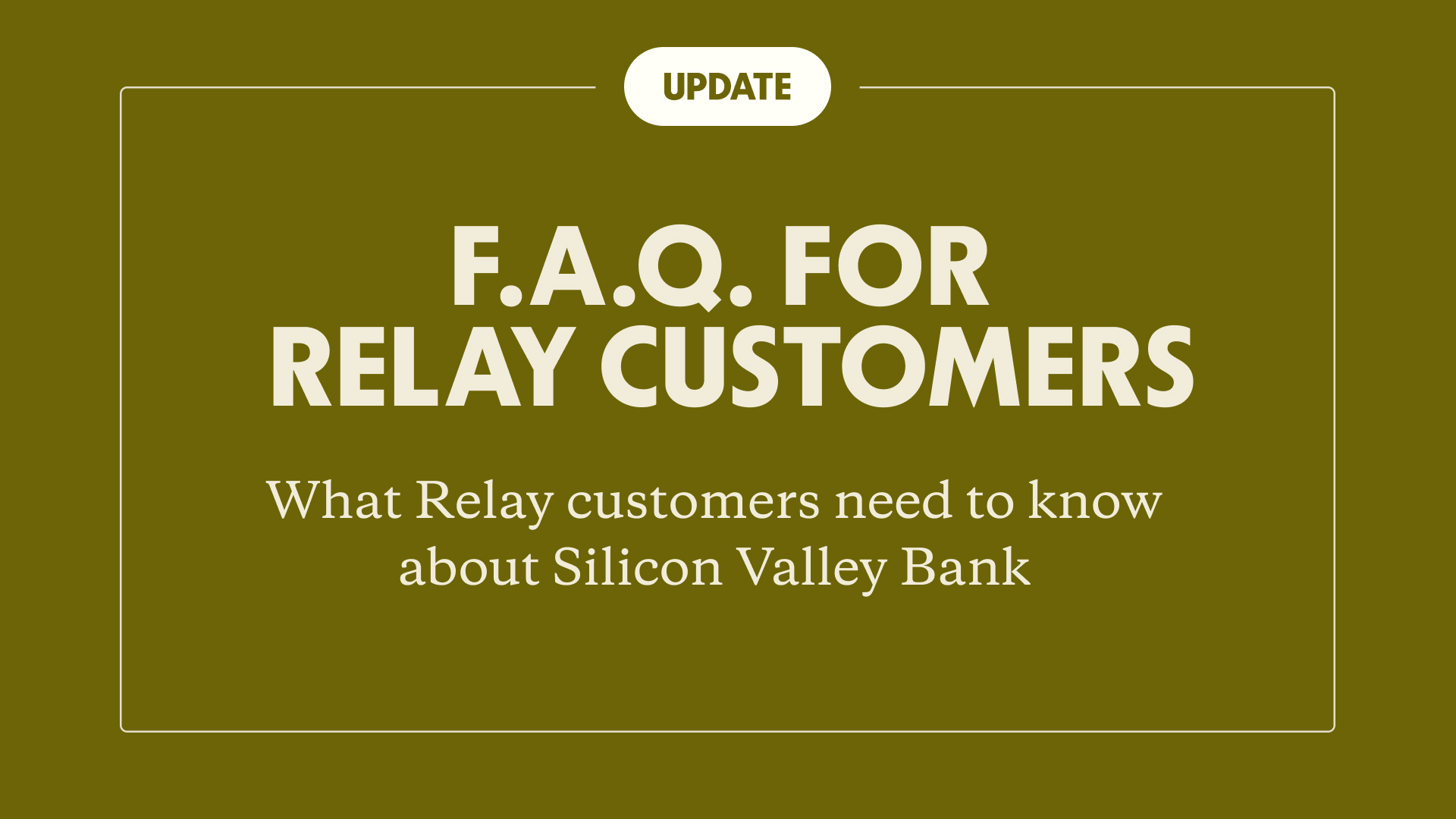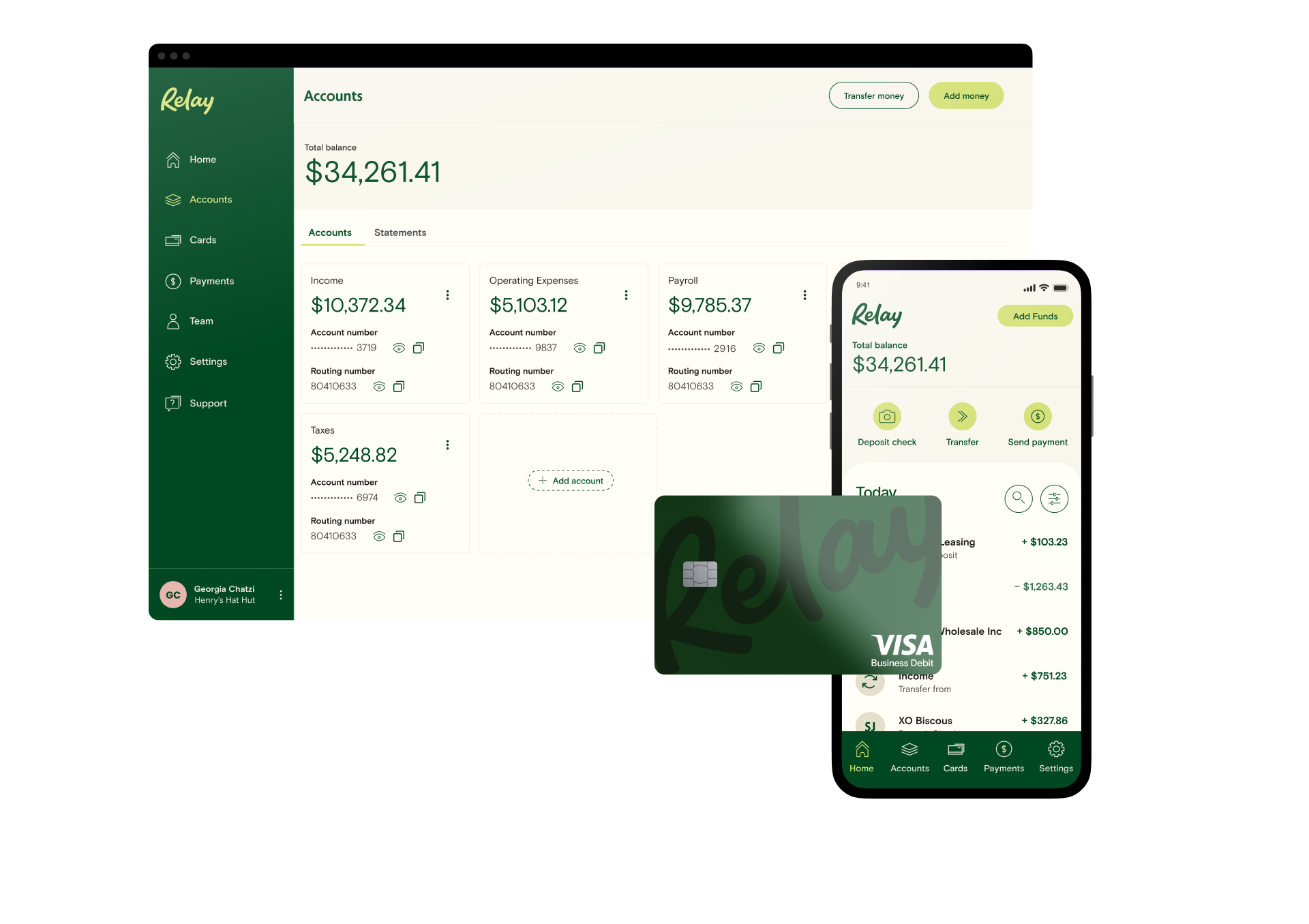Whether or not you’ve been directly impacted by Silicon Valley Bank’s (SVB) recent closure, as a business owner, you deserve clear guidance and transparent information about the safety of your money.
This F.A.Q. addresses your questions about how SVB's closure could impact your business.
Last updated: Monday, March 13th, 2023, at 11:30 a.m. ET
Does Relay have any exposure to Silicon Valley Bank?
No, Relay does not have any exposure to Silicon Valley Bank (SVB). Relay’s banking services are not affiliated with SVB. We also do not hold customer deposits or process any payments with SVB. Additionally, Relay does not hold any of our own business assets in SVB.
Is Relay a bank?
Relay is a banking technology company, not a bank. Relay does not directly handle customer deposits, but uses chartered partner banks to provide banking services. Currently, Relay works with two partner banks. For customers on Relay 2.0 (which includes all customers registered as of January 1, 2023), our partner bank is Thread Bank, which holds customer deposits and provides FDIC insurance up to $2,500,000 for each business on Relay.
Are Relay’s partner banks exposed to the same risks as SVB?
Our primary partner bank, Thread Bank, has taken explicit measures to avoid the type of geographic and industry-specific concentration that impacted SVB, and has based its strategy on diversification with partners such as Relay. All customers on Relay 2.0, as well as all customers who registered for Relay as of January 1, 2023, have checking accounts with Thread Bank.
Thread Bank is well-diversified across geographies and business verticals. While SVB was heavily concentrated in one vertical (technology startups) and narrow geographic areas, Thread Bank works with many partners, spanning multiple verticals and geographies. As a result, its customer base is more diversified compared to SVB’s, and is less susceptible to events that heavily impact a single industry.
Finally, Thread Bank is in a financially sound position. Its overall cash and liquidity position is in excess of industry peers, and it has over five times the liquidity position compared to SVB at the time of its failure.
Are Relay accounts FDIC-insured?
Each business entity under Relay 1.0 and Relay 2.0 accounts is insured by the FDIC through our partner banks Thread Bank.
Relay and Thread Bank, our primary partner bank, are offering an insured cash sweep program that provides additional protection to our customers. Customers that opt in to the program will receive expanded FDIC insurance that covers up to $2,500,000 in deposits.
Does Relay offer FDIC insurance above $250,000?
Relay and Thread Bank, our primary partner bank, are offering an insured cash sweep program that provides additional protection to our customers. Customers that opt in to the program will receive expanded FDIC insurance that covers up to $2,000,000 in deposits.
The program maximizes deposit insurance by sweeping money into other FDIC-insured banks. Each account opened through the program will hold a balance of $250k or less, and will be completely insured by the FDIC. This means protection in two ways: both by fully ensuring your balance, and by limiting deposit exposure across a single bank.
This program is only available for customers banking on Relay 2.0.
Will banking transactions be impacted by SVB being placed under receivership?
There may be some delays on incoming and outgoing wires over the next week due to a high volume of transactions our banking partners are seeing. Our partners have confirmed to us they are working diligently to minimize delays or disruptions. Additionally, there may be delays for customers moving money out of Silicon Valley Bank due to it being placed under receivership by the FDIC on Friday, March 10, 2023. For more information on how the closure impacts customers and next steps, please visit the FDIC.
What other ways does Relay protect its customers?
In addition to the FDIC insurance provided by our partner banks, Relay has a number of processes and practices in place to keep your account safe and protect against fraud. We employ industry-standard encryption to ensure secure and protected transmission of data.
Two-factor authentication (2FA) is required for Relay accounts. We consistently monitor our platform, log all points of access, and immediately alert our security team to unusual behavior. Our transaction monitoring systems alert customers to unauthorized spending activity in their accounts. For more information about how Relay works to keep your money and your data safe, see this article.
What is the Bank Term Funding Program (BTFP) and how does it protect me?
On Sunday, March 12th, the Federal Reserve unveiled a Bank Term Funding Program (BTFP), which introduces a new source of liquidity for U.S. banks, and as a result, adds another layer of protection for depositors.
BTFP directly addresses the type of illiquidity scenario that resulted in SVB’s closure and prevents a similar scenario from unfolding at another financial institution. As the Federal Reserve explains, “The BTFP will be an additional source of liquidity against high-quality securities, eliminating an institution's need to quickly sell those securities in times of stress.”
BTFP works by allowing a U.S. bank to borrow money from the central bank by putting up “U.S. Treasuries, agency debt and mortgage-backed securities” as collateral. In other words, banks have an additional way of quickly generating liquidity and making depositors whole in the event of a sudden increase in cash outflows. Most importantly, a bank’s collateral assets will be valued “at par” when borrowing from a central bank. This means that bond value fluctuations, which may have been impaired due to last year’s interest rate hikes, do not diminish how much a bank may borrow from the central bank. As a result, BTFP prevents another bank from experiencing the same illiquidity scenario that occurred at SVB.




